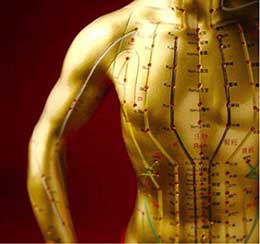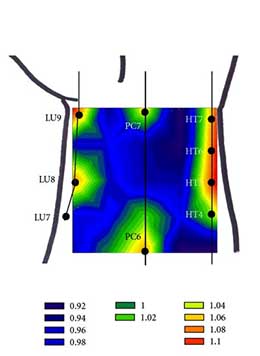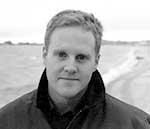Martial Arts: Judo
Acupuncture Points Verified with New Technology
By David Silver
 Acupuncture is the art of stimulating points in the body to improve circulation and remove blockages, either as a general tonic or to promote the healing of specific ailments. The acupuncture points were mapped out clearly in 1026 AD by Dr. Wang, Wei-Yi in his book ""Tong Ren Yu Xue Zhen Jiu Tu" (Illustration of the Brass Man Acupuncture and Moxibustion)". At that time, he also immortalized his detailed theory in the form of a brass man statue. For thousands of years, healers and meditators have experienced these points and the rivers of energy between them, known as meridians. Many documents detailing them can be traced back through Buddhism, Daoism, and yoga traditions. Acupuncture is the art of stimulating points in the body to improve circulation and remove blockages, either as a general tonic or to promote the healing of specific ailments. The acupuncture points were mapped out clearly in 1026 AD by Dr. Wang, Wei-Yi in his book ""Tong Ren Yu Xue Zhen Jiu Tu" (Illustration of the Brass Man Acupuncture and Moxibustion)". At that time, he also immortalized his detailed theory in the form of a brass man statue. For thousands of years, healers and meditators have experienced these points and the rivers of energy between them, known as meridians. Many documents detailing them can be traced back through Buddhism, Daoism, and yoga traditions.
These points, or cavities, are experienced as small areas with more energy than the surrounding skin, but the related physiology has never been understood. Statistical tests have repeatedly confirmed that acupuncture is more effective than random stimulus or "sham" acupuncture in improving recovery, promoting healing, and relieving discomfort. Acupuncture is indispensable for many injuries and ailments to the degree that it has been incorporated in all major hospitals around the world, but its function has remained elusive.
Now, recent improvements in computer processing have given us a look within the human body as never before. A CT (computerized tomography) scan is a series of X-rays used to create cross-sectional images. In a study published in the Journal of Electron Spectroscopy and Related Phenomena, researchers used in-line phase contrast CT imaging with synchrotron radiation to locate the physiological structures of the acupuncture points, or acupoints. The CT scans revealed clear distinctions between the anatomical structures of nonacupoint and acupoint areas.
It has been shown that acupoints have a higher density of micro-vessels and contain a large amount of involuted microvascular structures. The nonacupuncture areas of the body do not exhibit these properties. At the acupoints, microvascular densities with bifurcations "can be clearly seen around thick blood vessels" but non-acupuncture point areas showed few thick blood vessels and none showed fine, high density structures. The acupoints contained fine structures with more large blood vessels that are several dozen micrometers in size plus beds of high-density vascularization of vessels 15-50 micrometers in size. The researchers note that the size of an acupoint "can be estimated by the diameter of microvascular aggregations."
The researchers also noted that the state-of-the-art CT imaging techniques used in this study allow for improved three-dimensional (3D) imaging of a large field of view without artifacts, which greatly improves imaging of soft tissue. The researchers noted that "the high brightness, wide spectrum, high collimation, polarization and pulsed structure of synchrotron radiation" facilitated their discovery of the points. The acupuncture points ST36 (Zusanli) and ST37 (Shangjuxu) were shown to have very distinct structural differences compared to surrounding areas."
Confirming the Ancient Acupoints with Modern Science
The acupoints and meridians have also been measured in a growing body of evidence from other studies since the 1990s, using infrared imaging, LCD thermal photography, ultrasound and other CT imaging methods. Researchers used an amperometric oxygen microsensor to detect partial oxygen pressure variations at different locations on the anterior aspect of the wrist. The researchers concluded that partial oxygen pressure is significantly higher at acupuncture points. Below are images from the study measuring the increase of partial oxygen pressure combined with an overlay of the local acupuncture point locations. The images map the lung, pericardium and heart channels and their associated local points. It is interesting to note that these measurements are not needled points but are natural resting states of acupoints without stimulation.
 |
Acupuncture points P7 and P6 clearly show high oxygen pressure levels, as do the other acupuncture points in the region. |
Qi is "Energy"
In an age of intense backlash against anything considered pseudoscience or "fringe science" it is likely that the results of these studies of qi and acupuncture points will still be quickly discarded by skeptics who have little interest in considering the topic of human energy. Science is a process of seeking the truth through repeatable, controlled studies and experiments, followed by a years-long process of peer review. Practitioners of acupuncture, qigong, and TCM theory in general have been documenting their experience with investigations into human energy for thousands of years. A clear understanding of human energy has been a crucial aspect in the development of many disciplines, including acupuncture, meditation, yoga, qigong, and traditional Chinese medicine (TCM). Until the "energy anatomy" is agreed upon through many more modern Western medical studies, there will be no consensus on this topic.
It should not be such a leap of faith for people with a mechanistic view of the body to consider the existence of human energy. The measurement of the body's energy has been commonplace since the advent of the EEG and EKG in the early 1900s, and our understanding has improved with the invention more sensitive devices, including magnetometers and MRIs. Modern science discusses "ion channels" and the role of "electrically-charged proteins" in healing.
The problem lies in the continued misunderstanding that qi is some "other" type of special bioenergy, different somehow from our commonly accepted brainwaves, heart waves, and skin conductivity. Skeptics may quickly conclude that this research confirms that Qi is only related to oxygen molecules in the blood cells, or only the nervous system, without the realization that without energy these physical components of the body are lifeless, dead meat.
 |
The body's energy field (aura) has been measured to a distance of at least 18 to 20 feet away using a superconducting quantum interference device. |
Magnetic Resonance
In another study using MRI to monitor brain activity, researchers tested real acupuncture against sham acupuncture and found that using real acupuncture in correct acupoints consistently elicited brain responses in regions of the brain associated with the therapeutic effect the point is known for. Although physically located in close proximity, each acupuncture point elicited its own unique MRI response in the brain. The researchers note that, "Acupuncture at adjacent acupoints elicits distinct cerebral activation patterns, and those specific patterns might be involved in the mechanism of the specific therapeutic effects of different acupoints. The results confirmed the view that therapeutic
effects of acupuncture may work through the central nervous system pathway."
A wealth of recent MRI research has measured acupuncture point specificity. University of California School of Medicine (Irvine) researchers analyzed MRI based acupuncture studies and concluded that, "Recent evidence shows that stimulation of different points on the body causes distinct responses in hemodynamic, fMRI and central neural electrophysiological responses." It is important to note that the MRI findings demonstrated that "stimulation of different sets of acupoints leads to disease-specific neuronal responses, even when acupoints are located within the same spinal segment."
It is time for larger-scale peer reviewed studies to cross-reference the data regarding the "energy anatomy" of the body. If the existence and location of the acupoints and meridians are confirmed, then the next logical conclusion is that the detailed qigong and acupuncture theory now available should be considered an important guide for incorporating energy healing in a modern context. This ancient TCM theory offers a crucial holistic compliment to current ways of treating illness. Western medicine can advance quickly by considering the energetic aspect in healing.
I always joke with my qigong students that everything in Star Trek eventually becomes a reality. Perhaps during our lifetime we will see the widespread use of devices emitting beneficial frequencies to promote rapid healing.
This continued bridging of the East and West will help us to understand the human body more comprehensively, and help us to develop more tools for better healing and prevention of illness. But, it may take a hundred years for that modern scientific textbook to come out, explaining how acupuncture and qigong work. Until then, we have thousands of years of empirical evidence to learn from, the experience of masters who have passed down detailed theory so we may improve our circulation and health here and now.
References:
http://www.ncbi.nlm.nih.gov/pmc/?term=qi+gong
Alex Mogilner, Min Zhao. UC Davis, National Institutes of Health (grant GM068952)
Chenglin, Liu, Wang Xiaohu, Xu Hua, Liu Fang, Dang Ruishan, Zhang Dongming, Zhang Xinyi, Xie Honglan, and Xiao Tiqiao. "X-ray phase-contrast CT imaging of the acupoints based on synchrotron radiation." Journal of Electron Spectroscopy and Related Phenomena (2013).
Minyoung Hong, Sarah S. Park, Yejin Ha, et al., "Heterogeneity of Skin Surface Oxygen Level of Wrist in Relation to Acupuncture Point," Evidence-Based Complementary and Alternative Medicine, vol. 2012, Article ID 106762, 7 pages, 2012. doi:10.1155/2012/10a6762.
Yan X H, Zhang X Y, et al. Do acupuncture points exist? [J]. Physics in Medicine and Biology, 54 (2009):N143–N150.
Zhang Y, Yan X H, Liu C L, et al. Photoluminescence of acupuncture points "Waiqiu" in human superficial fascia [J]. J Lumin. 2006, 119-120:96-99.
Julia J. Tsuei, Scientific Evidence in Support of Acupuncture and Meridian Theory: I. Introduction. IEEE Engineering in Medicine and Biology Magazine. 1996, 15(3):58-63.
Li Lei, Yau To, Yau Chuen-heung. What Is the Origin of Acupoint. J. Acupunct. Tuina. Sci.2012, 10 (2):125-127.
Song X J, Zhang D. Study on the manifestation of facial infrared thermography induced by acupuncturing Guangming (GB 37) and Hegu (LI 4) [J]. Chinese Acupuncture & Moxibustion. 2010, 30(1):51-54.
Liu P, Zhou G Y, Zhang Y, et al. The hybrid GLM‒ ICA investigation on the neural mechanism of acupoint ST36: An fMRI study [J]. Neuroscience Letters, 2010, 479: 267-271.
Fei L, Cheng H S, et al. The experimental exploration and the research prospects about the material basis and the functional characteristics of the meridian [J]. Chinese Science Bulletin, 1998, 439(6):658-672.
Liu, Hua, Jian-Yang Xu, Lin Li, Bao-Ci Shan, Bin-Bin Nie, and Jing-quan Xue. "fMRI Evidence of Acupoints Specificity in Two Adjacent Acupoints." Evidence-Based Complementary and Alternative Medicine 2013 (2013).
Minagawa, Munenori, Yasuzo Kurono, Tatsuyo Ishigami, Atsushi Yamada, Toshinori Kakamu, Ryoichi Akai, and Junichiro Hayano. "Site-specific organ-selective effect of epifascial acupuncture on cardiac and gastric autonomic functions." Autonomic Neuroscience (2013).
A PET-CT study on specificity of acupoints through acupuncture treatment on migraine patients. Jie Yang1, Fang Zeng1, Yue Feng1,Li Fang1, Wei Qin2, Xuguang Liu1, Wenzhong Song3, Hongjun Xie3 , Ji Chen1, Fanrong Liang1.
Point specificity in acupuncture. Chinese Medicine 2012, 7:4 doi:10.1186/1749-8546-7-4. Emma M Choi, Fang Jiang, John C Longhurst. 
Susan Samueli Center for Integrative Medicine, Department of Medicine, School of Medicine, University of California, Irvine CA.
Republished with permission from YMAA.com
About The Author:
 David Silver has had a lifelong interest in meditation, and began training Gojū Ryū Karate at age 11. He studied Taijiquan, Qigong, and Yoga in his 20's, and became certified by world-renown Chinese martial arts master, Dr. Yang, Jwing-Ming, as a YMAA Qigong Instructor. He volunteers for the nonprofit YMAA Retreat Center. David Silver has had a lifelong interest in meditation, and began training Gojū Ryū Karate at age 11. He studied Taijiquan, Qigong, and Yoga in his 20's, and became certified by world-renown Chinese martial arts master, Dr. Yang, Jwing-Ming, as a YMAA Qigong Instructor. He volunteers for the nonprofit YMAA Retreat Center.
David works as a writer, producer, and director of instructional martial arts and health books and DVDs. He is the co-writer of the best-selling "Sunrise Tai Chi" book and DVD, "Tai Chi Energy Patterns" DVD, and "Sunset Tai Chi" book and DVD. He has produced many titles, including those by Dr. Yang, Jwing-Ming, a "Chen Taijiquan" DVD by Ren, GuangYi and rock music legend Lou Reed, and a series of Wudang mountain martial arts videos with Zhou, Xuan-Yun. David lives and teaches on Cape Cod, MA. |